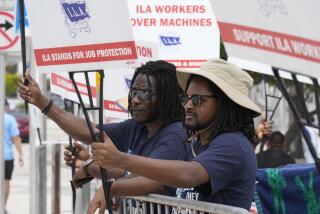N.Y. Rail Unions Agree to Return to Work
- Share via
NEW YORK — Four craft unions of the Long Island Rail Road agreed Wednesday night to return to work under a measure signed by President Reagan, ending an 11-day-old strike. Service on the nation’s largest commuter rail line was expected to be resumed Saturday.
With some reservations, Reagan signed a resolution rushed through Congress on Tuesday that requires the rail workers to return to their jobs for 60 days, a “cooling off” period designed to help negotiators reach a settlement.
Signalmen to Comply
The Brotherhood of Railroad Signalmen, one of the five remaining striking unions, had announced earlier Wednesday that it would comply with the resolution.
The railroad, which serves about 162,000 riders a day, had reached settlements or agreed to arbitration with 10 other unions.
The strike, which began on Jan. 18, forced commuters to take to cars and buses during two major snowstorms to make it to work each day.
The coalition of four of the railroad’s unions, representing about 2,500 workers, at first balked at complying with the resolution but later backed down and withdrew its pickets.
“Pickets are dropped, and we’re going back to work,” said David Morris, vice president of the Local 589 of the International Brotherhood of Electrical Workers, one of the four craft unions in the coalition. “The bill was signed by the President, and we elected to comply with the law and return to work.”
Morris earlier had called Reagan’s action a disappointment and said members might defy the legislation.
Rail Executive Jubilant
“The strike is over!” railroad President Bruce McIver exclaimed jubilantly. “ . . . As a result, we expect to resume regular service at 12:01 a.m. Saturday, and we should be in good shape for the Monday morning rush hour.”
In a statement issued after he signed the resolution, Reagan said: “The urgency with which this legislation was passed reflects the enormous hardship visited upon the communities served by the Long Island Rail Road that has been caused by the current strike.”
But the President questioned whether the government should intervene in the labor dispute, noting that federal railway labor law was supposed to be invoked only if a strike threatened “essential transportation services.”
“Characterizing the shutdown of the Long Island Rail Road as a threat to essential transportation services could have the undesirable effect of requiring federal involvement in the future in a multitude of local disputes which should be settled by collective bargaining,” Reagan said.
Struck Over Wages
The rail line’s employees struck primarily over wages and health and pension benefits, although the unions and management were never very far apart.
Railroad executives were gearing up to restore service to 700 miles of track, which entails finding employees and alerting them to return to work.
More to Read
Sign up for Essential California
The most important California stories and recommendations in your inbox every morning.
You may occasionally receive promotional content from the Los Angeles Times.










